

| This logger was designed to measure the number of elephant seal feeding behaviors. It detects the specific acceleration wave when seal eats food. It needs many program memories if you record original acceleration data. Elephant seal travels more than 200 days on the ocean. This logger detects feeding behavior and records that number every 5 seconds. This logger can record 214 days data. |
| Northern elephant seals come back to the shore at California twice a year. They breed babies and change their fur. Researchers remove and attach loggers at this chance. Elephant seals dive to get food under water about 20 minutes, and stay on the sea for breath about 5 minutes. They repeat this behavior intently. They dive normally 400 to 800 m, but occasionally more than 1000 m. |
| Elephant Seal |
| Northern Elephant Seal |
| Southern Elephant Seal |
Logger atached on the head of elephant seal
| PARAMETER | SPECIFICATION |
|---|---|
| PRESSURE-RESISTANT | 2000m |
| DEPTH | 0 to 2000m |
| TEMPERATURE | -10 to 50 Centigrade |
| FEEDING NUMBER | 0 to 15 times /5sec |
| SAMPLING | 5sec/point |
| RECORD TIME | 214 days |
| SIZE | 20mm fai X 100mm |
| This data shows that the elephant seal eats food at 800m depth. And after that the elephant seal is going up to surface. The data length is 10 minutes. Blue line shows depth, green line shows acceleration , and red line shows a feeding event that the logger analysis. The data shows that the elephant seal swims up and down to get food. The sharp peak of acceleration data is feeding event. |
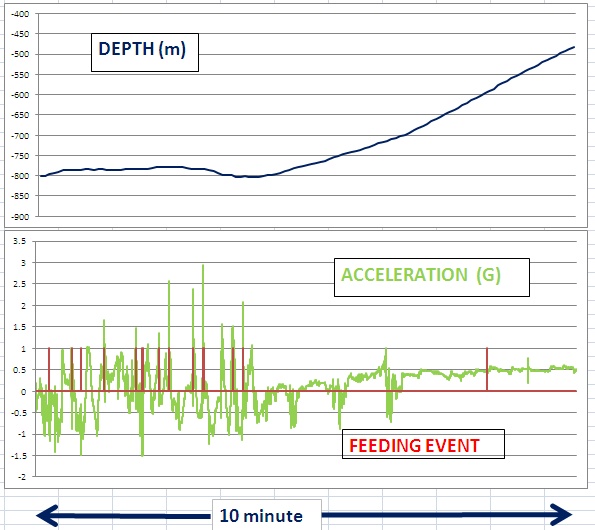
|
Unravelling the mysteries of a mesopelagic diet: a large apex predator specializes on small prey Yasuhiko Naito*1, Daniel P. Costa*2,Taiki Adachi*3, Patric W. Robinson*2,Melinda Fowler*2 and Akinori Takahashi*1,3 *1:National Institute of Polar Reserch.Tokyo Japan. *2:Center of Ocean Health, Institute of Marine Sciences,Long Marine Science University of California *3:Departmednt of Polar Science, Graduate Univercity of Advanced Study, Tokyo Japan Functional Ecology 2013,27,710-717 |
[SUMMARY]
1. To gain insight into the foraging behaviour of deep diving seals, we developed a long-term
jaw-motion recorder, which successfully measured the feeding attempts of four post-breeding
female northern elephant seals for 55-68 days during migration in the north-east Pacifc Ocean.
2. Using the jaw-motion recorders in conjunction with satellite tracking data, we first reveal
the three-dimensional fine-scale distribution of deep foraging activity in the north-east Pacifc
Ocean.
3. A large number of jaw-motion events (23,817-58,766 during 292-?4178 dives, per seal) were
observed with diel patterns suggesting their dependency on small mesopelagic prey. Calcula-
tionsusing at-sea field metabolic-rate and the photographs concurrently obtained by the head-
mountedcamera indicated feeding on small mesopelagic prey (10-20 g) including lantern fish
(F. Myctophidae).
4. The foraging behaviour of the northern elephant seal contrasts with echolocating toothed
whales, which make fewer feeding attempts, suggesting the whales forage more selectively. We
hypothesize that the continuous diving mode exhibited by this seal could be attributed to their
reliance on small prey and their less eficient epassive sensorsf for prey search, that is, their
vision or whiskers to detect prey.
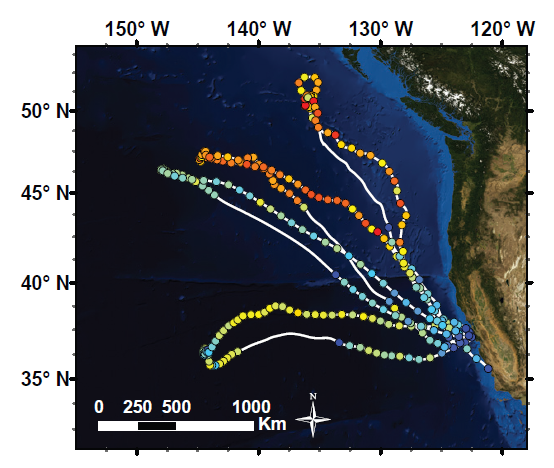
Migration pathes and jaw-motion events(JME) distribution of four female elephant sels.
Wamer colours indicate higher density of JME.
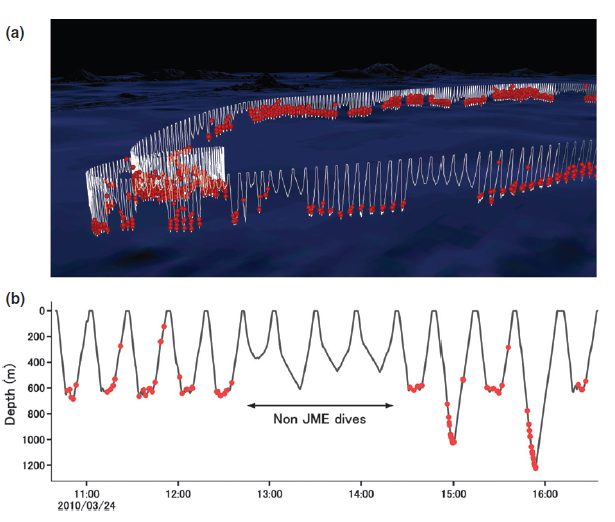
(a) Excerpted vew of three-demensimal distribution of JME (red dots) on the dive profile (white line)
along the migratory path in north-east Pacific and its bathymetric view.
(b) Time expanded excerpt showing JME appearance (red dots).
@ Although most of the dives were JME dives (80 -91%) and non-JME dives appeared in sequences consisting
largely of drift dives ,that is, passive sinking due to negative buoyancy starting at the inflection point, and its
varied form, a number of very deep dives ( >900m, subtype of transit dives; provisionally termed 'big dives') were
active foraging dives.
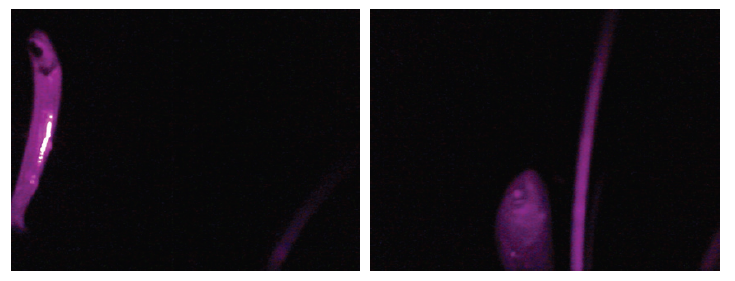
Images of fishes recorded by head-mounted infrared camera.
Although the qyality of images was inadequate for species identification, it was possible to assign them
to families Myctophidae (left) and Bathyagidae (right).
|
Aquatic animal telemetry: A@panoramic window into the underwater world Nigel E. Hussey, Steven T. Kessel, Kim Arestrup, Steven J. Cooke, Paul D. Cowley, Aaron T. Fisk,Robert G. Harcourt, Kim N. Holland, Sera J. Iverson, John F. Kocik, Joanna E. Mills Flemming, Fred G. Whoriskey Science 12 June 2015.VOL 348 ISSUE 6240 |
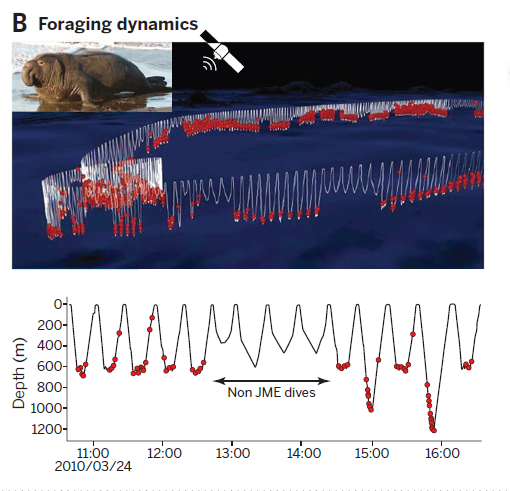
Paper 1 was refered by Science. Science Carried this figure.
|
The foraging benefits of being fat in a highly migratory marine mammal Taiki Adachi, Jennifer L. Maresh, Patrick W. Robinson, Sarah H. Peterson, Daniel P. Costa,Yasuhiko Naito,Yuuki Y. Watanabe, Akinori Takahashi y Proceedings of the Royal Society B, 5 November 2014. DOI: 10.1098/rspb.2014.2120 |
This paper used Stroke logger that is brother logger of Feediong event logger.Stroke logger analyzes the data of acceleration
and records the number of flipper strokes.
Abstract
Foraging theory predicts that breath-hold divers adjust the time spent foraging at depth relative to the energetic cost
of swimming, which varies with buoyancy (body density).
However, the buoyancy of diving animals varies as a function of their body condition, and the effects of these changes
on swimming costs and foraging behaviour have been poorly examined.
A novel animal-borne accelerometer was developed that recorded the number of flipper strokes, which allowed us to monitor
the number of strokes per metre swam (hereafter, referred to as strokes-per-metre) by female northern elephant seals over
their months-long, oceanic foraging migrations.
As negatively buoyant seals increased their fat stores and buoyancy, the strokes-per-metre increased slightly in the
buoyancy-aided direction (descending), but decreased significantly in the buoyancy-hindered direction (ascending), with
associated changes in swim speed and gliding duration.
Overall, the round-trip strokes-per-metre decreased and reached a minimum value when seals achieved neutral buoyancy.
Consistent with foraging theory, seals stayed longer at foraging depths when their round-trip strokes-per-metre was less.
Therefore, neutrally buoyant divers gained an energetic advantage via reduced swimming costs, which resulted in an increase
in time spent foraging at depth, suggesting a foraging benefit of being fat.
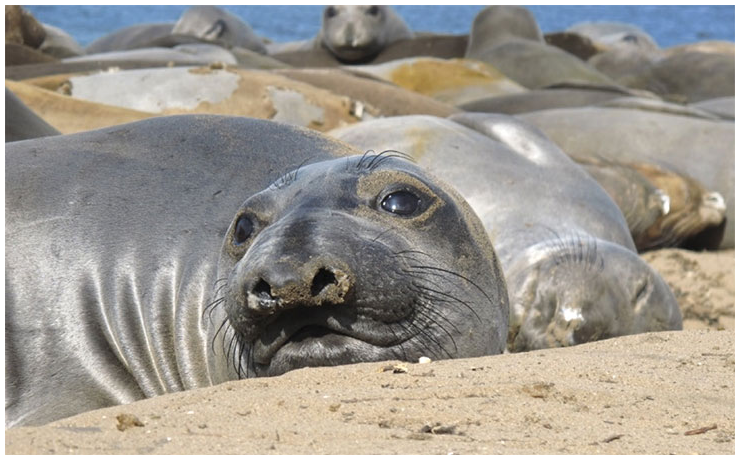
Female nothern elephant seal under moulting season. Before atach Stroke logger.@
(The Graduate University for Advanced Studies. National Institute of Polar Research)